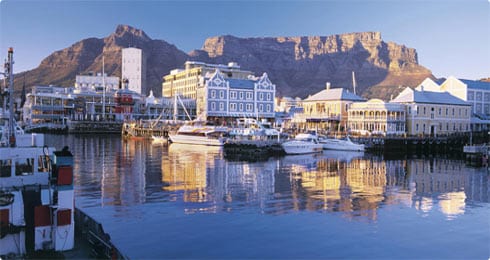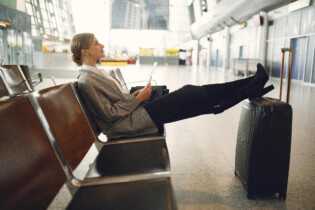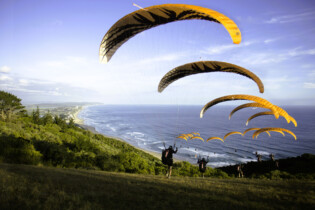A total of 9 188 368 international tourists visited South Africa in 2012, 10.2% more than the 8 339 354 tourists who travelled to the country in 2011, President Jacob Zuma announced in Cape Town today.
South Africa’s tourist growth rate in 2012 was more than double the rate of average global tourist growth of about 4% estimated by the United Nations World Tourism Organisation in 2012.
South Africa saw particularly good overseas tourist growth (tourists from outside of the African continent), which grew by 15.1%, one of the highest growth rates in the world last year.
Europe remained the highest source of overseas tourists to South Africa, growing by 9.5% on 2011 figures and attracting a total of 1 396 978 tourists to the country last year – more than half the total number of overseas tourists.
The United Kingdom continues to be South Africa’s biggest overseas tourism market, with 438 023 UK tourists travelling to South Africa in 2012 (4.2% up on 2011 figures). The United States is South Africa’s second biggest overseas tourism market, with 326 643 tourists from the USA visiting in 2012 (up 13.6% on 2011 figures), with Germany the third biggest overseas market with 266 333 tourists (up 13% on 2011 figures). China has become South Africa’s fourth biggest overseas tourism market, 132 334 (up 55.9% on 2011 figures), with France now South Africa’s fifth biggest overseas tourism market with 122 244 tourists in 2012 (up 16% on 2011 figures).
Particularly strong growth was recorded in 2012 from Asia (up 33.7% on the figures recorded in 2011), driven by growth from China and India, and Central and South America (up 37.0%), thanks to continued good tourist growth out of Brazil.
“We are extremely happy with our tourist arrivals figures for 2012 and our continued tourism growth from all regions. This phenomenal tourism growth is evidence that we are successfully setting ourselves apart in a competitive marketplace and that South Africa’s reputation as a friendly, welcoming, inspiring and unique tourism destination continues to grow,” said President Zuma, when announcing the 2012 international tourism statistics at a media briefing at the Victoria and Alfred Waterfront today.
President Zuma said that the 2012 tourist growth figures confirmed that the country’s tourism marketing efforts were on track, backed by a strong, professional tourism industry that offered a wide variety of tourist offerings to suit every experience and every budget.
“These figures give us confidence that we are making good progress in our efforts to grow the tourism industry in South Africa. But we cannot become complacent. More and more countries around the world are realising the opportunity that tourism presents for growing their economies and creating jobs and our geographic position makes our fight for the global tourism share more difficult than most. As a tourism industry we have to remain committed to working together to grow tourism to our country, with the support of all South Africans, all of whom have the power to be important tourism ambassadors,” said President Zuma.
While President Zuma emphasised the importance of continuing to maintain and grow the country’s market share in its core markets of Europe and North America, he was excited about the growth recorded from the emerging markets of regional Africa, Asia and South America.
“A few years ago we took the decision to begin actively marketing destination South Africa in emerging markets, which has yielded extremely positive results. Since 2009 arrivals from China have more than tripled, arrivals from Brazil have more than doubled and arrivals from India have almost doubled,” said President Zuma.
China jumped from being South Africa’s eighth largest overseas source market in 2011 to its fourth largest overseas source market in 2012. In 2012, 132 334 people visited South Africa from China, a 55.9% increase in growth, driven in part by the opening up of a direct flight between Beijing and Johannesburg in January 2012.
The impressive growth in arrivals from India continued in 2012, with 106 774 Indian visitors to South Africa, growth of 18.2%, making it South Africa’s eighth largest overseas source market.
Brazil continued to show impressive growth rates becoming a top ten overseas source market for arrivals for the first time (ninth). A total of 78 376 Brazilians came to South Africa in 2012, a 44.7% increase on 2011 numbers.
“The BRICS summit held in Durban last month highlighted the economic potential that our affiliation with this bloc has for South Africa and the tourism industry is no exception. Tourist arrivals from the BRICS countries accounted for 330 834 of our international tourist numbers in 2012 and the potential for further growth is huge. Greater collaboration at this level will no doubt go a long way in making South Africa a more accessible destination for visitors from these markets and ensuring that these countries continue to fuel our industry’s success going forward,” said President Zuma.
“Regional Africa remains the pillar of our tourism economy and we are happy to see that arrivals from the region have maintained the solid growth path we have become accustomed to. Africa’s importance to our tourism industry will continue to grow, as African economies are amongst the best performing economies in the world at the moment,” President Zuma added
Foreign tourists spent a total of R76.4 billion in South Africa last year, up 7.6% on the total foreign direct spend in the country in 2011. Spend by tourists from the Americas, Asia & Australsia as well as Europe have all increased. The only decrease in spend was from tourists from our continental land markets, which lead to the average spend per tourist decreasing by 2,3%.
The average length of stay decreased from 8.5 nights per tourist in 2011 to 7.6 nights in 2012 driven off shorter stays by tourists from most of our markets. This is a global trend that affects all our competitors due to the economic downturn around the world.
President Zuma also referred to the latest Tourism Satellite Account (TSA) released by Statistics South Africa, for the period ending December 2011. The TSA provides a tourism dimension to the System of National Accounts and contains important information about the performance of the Tourism Sector in the economy. The TSA reported the following results:
• Direct tourism contribution to GDP went up by 5% to R84.3 billion in 2011.
• Direct employment in the sector as a percentage of overall employment in the country went up from 4.3% to 4.5% between 2010 and 2011. This was as a result of the increase of about 31,000 direct jobs in the sector from 2010 to a total direct employment of 598,432 in 2011.
• An increase of 3.3% in expenditure by foreign tourists to R71.7 billion.
• The total domestic tourism expenditure increased from R69 billion in 2010 to R101 billion in 2011, which translates to an increase of over R30 billion.
These results clearly show that we are well on our way to achieving the goals that we have set for ourselves for the tourism sector.
PRESIDENT’S SPEECH
I stand here before you today in the V & A Waterfront, the gateway to Robben Island, only two days before our Freedom Day celebrations and just a year before the marking of 20 years of our freedom and democracy.
We are very proud that a country that was once a pariah state is now attracting more international visitors each year.
In 1993, South Africa received a mere 3.4 million foreign visitors. By 2012, the figure had grown by 300 percent to 13.5 million visitors, of which 9.2 million were tourists.
The magnificent growth in tourism figures is a positive outcome of our transition to a democratic dispensation. The fruits of our freedom have indeed come in many forms.
These results also demonstrate the effectiveness of our economic diplomacy underpinned by a sound foreign policy.
This positive trend is continuing due to our systematic investment in policy and strategy development as well as effective implementation.
In 2009 we decided to create a stand-alone National Department of Tourism as we knew the potential of tourism as a job creator and also as a sector that would open our beautiful country to the world.
Tourism was subsequently identified as one of the key sectors envisaged in our New Growth Path economic strategy as one of six job drivers. The others are mining, manufacturing, the green economy, infrastructure development and agriculture.
Tourism also has the potential to provide more youth business and employment opportunities.
Our National Tourism Sector Strategy, developed in partnership with all spheres of government, the private sector and other role players, envisions South Africa as among the top 20 world tourist destinations by 2020.
Our objective is to grow our share of the over one billion annual tourist arrivals from the global tourism market and also to further grow our domestic market.
Most importantly, our strategy has two main outcomes, namely creating 225 000 additional jobs and contributing about half a trillion rand to the country’s Gross Domestic Product by 2020.
It now gives me great pleasure to share with you our country’s annual tourism performance for 2012.
A total of 9 188 368 international tourists visited South Africa in 2012. This was 10.2% more than 8 339 354 tourists who travelled to the country in 2011.
This was also more than double the global average in tourist growth, which has been estimated as being at around 4% by the United Nations World Tourism Organisation.
Europe remained the highest source of overseas tourists to South Africa, growing by 9.5% on 2011 figures. We attracted 1 396 978 European tourists to the country last year.
The United Kingdom continues to be South Africa’s biggest overseas tourism market, with 438 023) UK tourists travelling to South Africa in 2012, which is 4.2% up on 2011 figures.
The United States is South Africa’s second biggest overseas tourism market, with 326 643 tourists from the USA visiting in 2012, up 13.6% on 2011 figures.
Germany is the third biggest overseas market with 266 333 tourists up 13% on 2011 figures.
France is now South Africa’s fifth biggest overseas tourism market with 122 244 tourists in 2012, up 16% on 2011 figures.
A few years ago we took the decision to begin actively marketing South Africa in emerging markets, which has yielded extremely positive results.
Asia as a region is up 33.7% on the figures recorded in 2011, driven by growth from China and India, and Central and South America.
Since 2009, arrivals from China have more than tripled, arrivals from Brazil have more than doubled and arrivals from India have almost doubled.
China has become South Africa’s fourth biggest overseas tourism market at 132 334 tourists last year, up 55.9% on 2011 figures.
The impressive growth in arrivals from India continued in 2012, with 106 774 Indian visitors to South Africa, a growth of 18.2%, making India South Africa’s eighth largest overseas source market.
Brazil continued to show impressive growth rates becoming a top ten overseas source market for arrivals for the first time, at ninth position. A total of 78 376 Brazilians came to South Africa in 2012, a 44.7% increase on 2011 numbers.
Africa remains the pillar of our tourism economy and we are happy to see that arrivals from the region have maintained the solid growth path we have become accustomed to. Growth from our own continent was up by 8,5%.
Foreign tourists spent a total of R76.4 billion in South Africa last year, up 7.6% on the total foreign direct spend in the country in 2011.
The expenditure by tourists from the Americas, Asia and Australasia as well as Europe has also increased.
The only decrease in spend was from tourists from our African markets, which led to the average spend per tourist decreasing by 2,3%.
In addition, the average length of stay decreased from 8.5 nights per tourist in 2011 to 7.6 nights in 2012. The shorter stays are a global trend that affects all our competitors due to the global economic meltdown.
This phenomenal tourism growth is evidence that we are successfully setting ourselves apart in a competitive marketplace.
It indicates that South Africa’s reputation as a friendly, welcoming, inspiring and unique tourism destination continues to grow.
I am also pleased to share with you the preliminary edition of the latest Tourism Satellite Account which has been released by Statistics SA, for the period ending December 2011.
Direct tourism contribution to the GDP went up by 5% to 84.3 billion rand in 2011. Direct employment in the sector as a percentage of overall employment in the country went up from 4.3% to 4.5% between 2010 and 2011.
This resulted from the increase of about thirty one thousand direct jobs in the sector from 2010 to a total direct employment of 598,432 in 2011.
The total domestic tourism expenditure increased from 69 billion rand in 2010 to one hundred and one billion rand in 2011, which translates to an increase of over 30 billion rand.
The outstanding performance will be further enhanced by closer collaboration between South African Tourism and our over 100 diplomatic missions across the world.
When I addressed our heads of foreign missions in Pretoria earlier this month, I impressed upon them the need to prioritise communication and the marketing of our country. We expect to see positive results.
We are also happy to be releasing these exciting tourism figures just a week before the World Economic Forum Africa conference to be held here in Cape Town from 8 to 10 May.
South Africa will once again host Heads of State and Government and global and domestic captains of commerce and industry.
This conference, to be held under the theme “Delivering on Africa’s Promise”, will provide an opportunity to advance the African Agenda of economic growth and development.
We invite the people of Cape Town and South Africa as a whole to ensure the warmest welcome to the World Economic Forum high level delegates.
We once again have an opportunity to prove our expertise in hosting events of this magnitude.
Allow me to use this opportunity once again to congratulate and thank all South Africans for ensuring the success of our tourism strategy.
In addition to the beauty of our country and its outstanding facilities, it is because South Africans treat visitors warmly and hospitably that we see such positive results.
Let me also congratulate the Minister of Tourism and the entire tourism sector for this performance. The fruits of your hard work are visible.
These figures give us confidence that we are making good progress in our efforts to grow the tourism industry in South Africa. But we cannot become complacent.
More and more countries around the world are realising the opportunity that tourism presents for growing their economies and creating jobs. Our geographic position makes our fight for the global tourism share more difficult than most.
As a tourism industry we have to remain committed to working together to grow tourism to our country, with the support of all South Africans.
As we prepare to celebrate Freedom Day, let me invite every South African to be an ambassador of the Republic. Let us all market our beautiful country diligently and passionately to one another and to Africa and the world.
We have done exceptionally well since the democratic transition in 1994. We have a story to tell, and a beautiful country to show off to the world.
Working together, we can do so much more!
I thank you.







